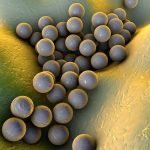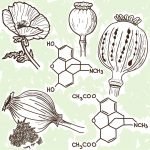MRSA and Ayurvedic Medicine
Virender Sodhi, MD (Ayurved), ND
Staphylococcus aureus, commonly known as Staph aureus or just “Staph,” is a strain of bacteria that normally colonizes the skin and nose of its human hosts. Usually asymptomatic, these colonies can lead to infections if the bacterial population grows unchecked by the immune system. These infections may be easily curbed by the use of immune stimulants and appropriate antibiotic medications. However, methicillin-resistant Staphylococcus aureus, usually called MRSA, is, as the name suggests, resistant to antibiotic treatment. The occurrence of this strain has been steadily growing in the past few decades. Studies show that as many as 1 out of 3 people carry Staph aureus in their noses, while about 1 out of 100 people carry MRSA.
Prevalence
A 2008 study estimated that in 2001-2002, “approximately 29% (78.9 million persons) and 1.5% (4.1 million persons) of the U.S. population was colonized in the nose with S. aureus and MRSA, respectively.”2 Another study estimated that up to 478 000 hospitalizations related to Staph infection were recorded in US hospitals in 2005. Of these, 278 000 hospitalizations were related to MRSA.3 All of these were community-acquired MRSA infections. The Centers for Disease Control and Prevention (CDC) reports that even though the majority of MSRA infections are community-acquired, it is the nosocomial infections (infections acquired 48-72 hours after hospitalization) that result in higher rates of morbidity and mortality.3 The trend for hospital-acquired, or nosocomial, infections has taken on troublesome proportions over the past 20 years: In 1992, 35.9% of Staphylococcal infections in US intensive care units were due to MRSA, compared to 64% in 2004.4
What is Most Troublesome?
Antibiotic-resistant strains of bacteria have been growing in prevalence. The root of this problem has been primarily attributed to overuse of antibiotics in general practice and hospital settings. As many as 60% of infections causing sore throat are treated with antibiotics, while antibiotic-sensitive Group A Streptococcus is present in only 10% of cases.5 This trend has only slightly changed since the early 1990s, when the rate of treatment of sore throat with antibiotics dropped from 80% to 70%; since around 2000, the rate has stayed at approximately about 60%.5 Unfortunately, the damage seems to have been done, as demonstrated by growing trend of MRSA infections in hospital settings, described above.This overuse of antibiotics seems to place adaptive-stress on normal Staph aureus to develop antibiotic resistance. Going a step further, these resistant bacteria are then able to share genetic information that promotes drug-resistance in other bacteria.6 Every time bacteria become resistant to certain drugs, conventional treatment options become fewer, thus making infections more challenging to treat.
What is the Natural Solution?
The ancient Ayurvedic physicians gave a simple instruction to their disciples regarding health-care: “Swasthasya rakshanam,” meaning “health is inherent; our job is to help maintain it.” The human may die of old age and time-worn organs, but before this, health is to be maintained by establishing a healthy balance in day-to-day life.
The Human Ecosystem
Ayurveda teaches us the idea of the human ecosystem, which is described as the concept of prakriti, or individual constitution. Balance in the ecosystem is attained by tending to 3 pillars of health: diet, exercise, and sleep.
Diet is basis of nourishment and regeneration for all of our tissues. It provides the essential nutrients that create new cells, maintain normal function of cells, and eliminate waste products from cells. It is recommended that one consumes a seasonal diet of fresh fruits, vegetables, grains, and animal products. Old food is considered rancid. In fact, such food is now known to have higher amounts of histidine created by the bacteria, which can lead to allergic-type food reactions. Fortunately, local organic food that is available at farmer’s markets changes with seasons and readily facilitates a diet of fresh foods that change with the season.
Bacteria are a natural part of the human ecosystem. There are 10 times as many bacteria in the human as cells of human origin. Maintaining populations of these allies is recommended through appropriate, regular intake of fermented foods. Even these may change by the seasons. For example, while yogurt is useful throughout the year, fermented barley may be used in the summer, fermented mustard in the rainy cool season, and fermented black sesame in the winter season; these are just some of the recommendations.
A moderate level of exercise done daily in association with breathing exercises, called pranayama, can promote adequate oxygenation of the blood. This supports vitality of the body by encouraging increased metabolism, thus improving digestion and assimilation of nutrition. Oxygen also supports the antibacterial oxidative function of neutrophils and other immune cells.
Sleep is the time when the body heals, as it is free from the external assaults and stresses of daily living. Having a sleep-wake cycle in agreement with circadian rhythms of the hormones promotes optimal function of healing mechanisms and supports immune system function.7
Daily routines are additional ways to boost immune function. In the case of MRSA, our nose is the first place in which we can defend ourselves. Conventional medicine practice uses antibiotic nasal spray to kill local bacteria, but this may also contribute to antibiotic resistance among bacteria. In contrast, daily practice of oleation of the nose, called nasya, can provide essential fatty acids that strengthen the cell membranes, improve intercellular communication, and reduce inflammation in the nose and sinuses. Nasya has been proven quite beneficial in treatment of chronic sinusitis.8 Another helpful routine is massage of the whole body with specific oils, which has similar effects on the skin, where most MRSA infections occur. Coconut oil is used for the Pifa constitution, Vata is balanced by sesame oil, while Kapha gains balance from olive or mustard oils, which are warming and light due to high concentration of monounsaturated fatty acids. Mustard oil is my favorite because it has sulfur compounds that promote cellular and whole-body detoxification.
Herbal Treatment
Neem is a general cleansing herb, described as a blood cleanser in Ayurvedic tradition. In a way that is similar to antibiotics, neem afains its antimicrobial activity through direct toxicity to the bacteria, including MRSA.9,10 Neem has been shown in animal studies to effectively lower blood sugar, which starves the invasive microbes that thrive on high glucose; furthermore, it changes DNA expression of cells to increase the activity of immune cells.11Turmeric, specifically its curcumin component, is one of the best-known inflammation modulators. This herb serves its purpose by controlling inflammation of tissue. Inflammatory fluid provides a rich medium for bacteria to propagate, and tissue damage secondary to inflammation allows bacteria access to deeper tissues. Curcumin has been shown to have synergistic action with antibiotic and light therapy for MRSA infections, effectively reducing the amount needed in treatment.12,13 A traditional combination of 3 herbs (Terminalia chebula, Terminalia belerica, and Emblica officinalis) has been used for hundreds of years in Ayurveda for its antioxidant and rejuvenating qualities, referred to as rasayana. Amla (Emblica officinalis) is one of richest sources of vitamin C, a primary antioxidant in the body. It has also been shown to improve efficacy of antimicrobial treatment of MRSA.14 Charak described the gastrointestinal tract as the main site of action for this herbal combination. In my experience, I have found that it can help normalize the population of gut bacteria.
Case Reports
My first experience treating Staph aureus infections was in India. Often, during the rainy months of August and July, many villagers would come in with complaints of boils on their limbs or back, along with a fever up to 102 °F. My grandmother would harvest fresh neem leaves, grind them to a paste, then infuse this paste with hot water. The medicinal neem-infused water was used to wash the infected area. Additionally, Grandmother would prepare a neem chutney to be eaten daily for 40 days. While the neem wash would treat the local infection, eating the extremely bifer neem chutney would prevent recurrence of Staph infection. Over the years, I have seen many cases of MRSA at my office in Bellevue, WA, some of which are recounted below.
Case Study 1
An engineer from Boeing came into my office one day, distressed about his recurrent MRSA infections. He was a young, tall, and robust man, who was on the verge of tears when he spoke about his infections. He complained that the infections had recurred 6 times in the past year, affecting his legs, neck, and back. Each was sent to the hospital to be treated with IV antibiotics, only to have the infection return within the next few weeks. He had come into my office to prevent another occurrence. On taking the history, I realized that this young man had a tendency to eat a high-sugar diet and processed/frozen foods,he didn’t get adequate exercise, and was also under a lot of stress. I explained to him that we would take a holistic approach that would affect change in his lifestyle, diet, and metabolism to prevent the MRSA from colonizing and thus creating infection. He agreed with the plan. His treatment consisted of the following:
•Changing his diet: Increase fresh proteins and fats in his diet, little to no sugar intake, and limited fruit intake
•Enhancing his exercise regime: Incorporate regular yoga, a moderate level of physical exercise, and specific breathing exercises (pranayamas)
•Supplements: 1 tsp curcumin in coconut milk TID, 1 capsule of a neem product BID, and a daily probiotic containing 100 billion CFUs
The young man returned in 3 weeks, with no recurrence of MRSA. I asked him to continue on the protocol for 9 months before stopping the supplements. Now, after 15 years of his first visit, he has not had any more MSRA infections.
Case Study 2
A middle-aged man came to our office with a MRSA infection on the right corner of his lips. The infection had pustules surrounded by red, corroded skin that seemed to be eaten away by inflammation. His primary care physician had offered IV antibiotics but he “ran in the other direction.” Thus, he came to our office for urgent treatment. I explained to him that I could try to help him but we would need to watch the infection like a hawk. My concern was the proximity of the infection to his brain, as well as the possibility of it becoming a systemic infection by entering his bloodstream. I instructed him that he must call me immediately if he experienced any aggravation or developed a fever.
Treatment:
- I prepared a paste with neem powder, curcumin, and Epsom salts, which he applied multiple times daily. I gave him a prescription of an oral Neem product (2 capsules TID), also 1 tsp of a curcumin product TID.
- Dietary recommendations: Fresh fish (easily available in the Pacific Northwest), fresh vegetables, and very limited sugar intake
He returned to my office the following day for a check-up. We noticed that the infected area had begun drying out. Upon his return in 3 more days, the infected area had completely dried and had developed a scab. There was no sign of active infection.
 Virender Sodhi, MD (Ayurved), ND was the first Ayurvedic and naturopathic physician in the United States. He earned an MD (Ayurved) degree in 1980 in India, and served as a college professor there until 1986, when the government select-ed him to share Ayurveda with Western society as part of a cultural exchange program. He finished a fellowship in Integrative Oncology in 2012. Dr Sodhi received his ND degree from Bastyr University in 1988 and then joined the faculty to teach Ayurvedic sciences. He is currently a visiting professor at SCNM in Scottsdale, AZ, at the University of WA School of Pharmacy, and at Des Moines University in Iowa. He is also writing a book on Ayurvedic medicine and treating patients at the Ayurvedic & Naturopathic Medical Clinic in Bellevue, WA.
Virender Sodhi, MD (Ayurved), ND was the first Ayurvedic and naturopathic physician in the United States. He earned an MD (Ayurved) degree in 1980 in India, and served as a college professor there until 1986, when the government select-ed him to share Ayurveda with Western society as part of a cultural exchange program. He finished a fellowship in Integrative Oncology in 2012. Dr Sodhi received his ND degree from Bastyr University in 1988 and then joined the faculty to teach Ayurvedic sciences. He is currently a visiting professor at SCNM in Scottsdale, AZ, at the University of WA School of Pharmacy, and at Des Moines University in Iowa. He is also writing a book on Ayurvedic medicine and treating patients at the Ayurvedic & Naturopathic Medical Clinic in Bellevue, WA.









